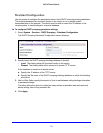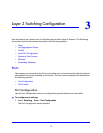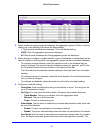
80
XS712T Smart Switch
Link Aggregation Groups
Link aggregation groups (LAGs), which are also known as port channels, allow you to
combine multiple full-duplex Ethernet links into a single logical link. Network devices treat the
aggregation as if it were a single link, which increases fault tolerance and provides load
sharing. You assign the LAG VLAN membership after you create a LAG. The LAG by default
becomes member of default management VLAN (i.e, 1).
A LAG interface can be either static or dynamic, but not both. All members of a LAG must
p
articipate in the same protocols. A static port-channel interface does not require a partner
system to be able to aggregate its member ports.
Static LAGs are supported. When a port is added to a LAG as a static member, it neither
transmit
s nor receives LAGPDUs. The XS712T Smart Switch supports eight LAGs.
The LAGs menu contains links described
in the following sections.
• LAG Configuration
• LAG Membership
• LACP Configuration
• LACP Port Configuration
LAG Configuration
Use the LAG (Port Channel) Configuration screen to group one or more full-duplex Ethernet
links to be aggregated together to form a link aggregation group, which is also known as a
port-channel. The switch treats the LAG as if it were a single link.
To configure LAG settings:
1. Select Sw
itching LAG Basic LAG Configuration.
2. Select the check box next to the LAG to configure.
You can select multiple LAGs to apply the same setting to the selected interfaces. Select
the check bo
x in the heading row to apply the same settings to all interfaces.
3. Configu
re or view the following settings:


















